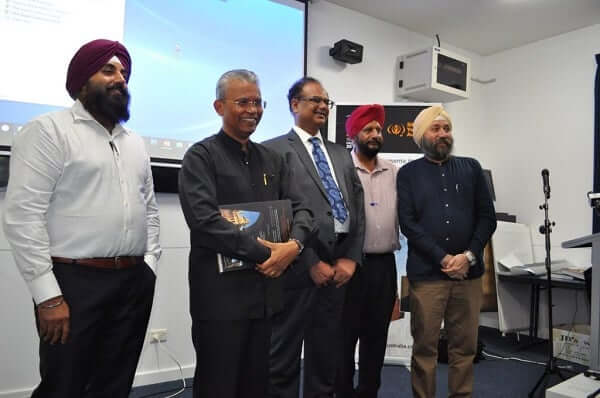The Partition of India which saw the state of Punjab ripped at the seams, has long stirred passions and elicited strong emotions in the hearts of Indians and Pakistanis alike. However, on a warm Saturday afternoon at Sikh Youth Australia’s 20th Annual Summer Camp, author Amandeep Singh unveiled a project that challenged his audience to look beyond their pain and differences on the matter.
In the presence of esteemed guests, including India’s High Commissioner to Australia Dr AM Gondane and the Deputy High Commissioner of Pakistan to Australia Dr Muhammad Khalid Ejaz, Singh launched his book The Lost Heritage: The Quest Continues.

The book takes readers on a journey across Pakistan, uncovering the multifaceted Sikh and wider Punjabi legacy lost with the partition of Punjab in 1947, that spans beyond just religious sites to architectural masterpieces, artistic relics and historical forts to name but a few.
The comprehensive volume that consists of over 500 pages, was born out of Singh’s visits to a combined 126 cities and villages across Pakistan. However, instead of proving overwhelming, the interspersion of photographs and anecdotes throughout, serves to add a sense of intimacy that resonates with members of all communities. For instance, Singh relates powerful encounters he had with locals such as the Nanakpanthis of Balochistan and Sindh, who are 4 million in number and who, despite not following all forms of Sikhism, live by and preach the teachings of Guru Nanak, the founder and first Guru of Sikhism.
Singh challenged that these individuals constitute a thriving Sikh community in the depths of Pakistan beyond just the well-known enclaves of prominent gurdwaras such as Nankana Sahib and Panja Sahib, whose entry is reserved solely for Sikhs in the traditional sense.
Greater inspection of the book evokes the sense that an intrinsically shared legacy is being unveiled that derives from a time when differences where not viewed as so stark. On several occasions, Singh discovers the very tales and figures once venerated by Sikhs are still today celebrated in Pakistan, albeit on different terms. For instance, the Sikh figure Baba Than Singh heralded from Fateh Khan in the Attock district of Pakistan and before 1947, a namesake gurdwara stood in Fateh Khan fostered by the local Sikh community. After their exodus during partition, Pakistani locals, despite converting the Gurdwara for alternative uses, maintained the building and continued to revere Baba Than Singh by reforming him as the more culturally acceptable Sultan Than Singh. On his 2017 visit to the once Gurdwara, Singh discovered that despite the decay of the physical building, locals still lit a candle each Friday out of respect for their Sultan Than Singh.
The making of the book itself is a testament to the growing integration between India and Pakistan that must be fostered to reclaim such lost shared legacies. When the preceding volume of The Lost Heritage was launched at the 2016 Sikh Youth Australia Family Camp, it was in the presence of Defence Attaché to the High Commissioner of Pakistan to Australia, Brigadier Muhamad Ashgar. Moved by Singh’s unpolitical quest to uncover the combined heritage lost during partition, Brigadier Ashgar arranged for Singh’s 2017 trip through 90 cities and villages in Pakistan, accompanied by an army escort that afforded him unprecedented access to historical sights and enabled the composition of the second book. At Sikh Youth Australia’s January 2017 launch of this second volume the Deputy High Commissioner of Pakistan to Australia Dr Muhammad Khalid Ejaz cited Guru Nanak as one of the best examples of religious tolerance and reflected on the commonalities in the experiences of Punjabis across India and Pakistan who, regardless of religion, have a fundamentally intertwined history of living and working side by side.

At the conclusion of the launch, Singh remarked on the human emotion that underscored all of his encounters and experiences throughout Pakistan. He noted that there was an overwhelming feeling of hope in the sentiments of those he met, hope for a future that sees an integration where the Sikh Punjabi heritage and legacies elucidated in his book and beyond need not be ‘lost’ forever.
The launch and reception of the distinguished guests was facilitated thanks to Sikh Youth Australia, an organisation that has been dedicated to promoting a greater understanding and awareness of Sikh culture, identity and heritage since its 1999 establishment. Sikh Youth Australia has been involved in numerous collaborations and projects over its lifetime and this January successfully ran its 20th Annual Summer Camp with over 400 participants.
Punjab beyond borders

Reading Time: 3 minutes



